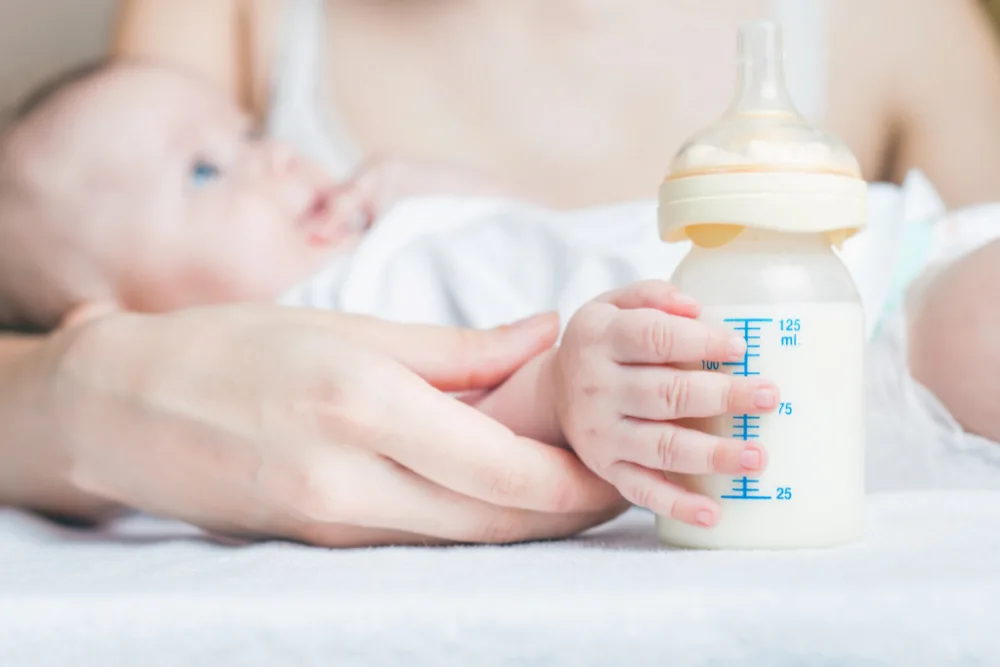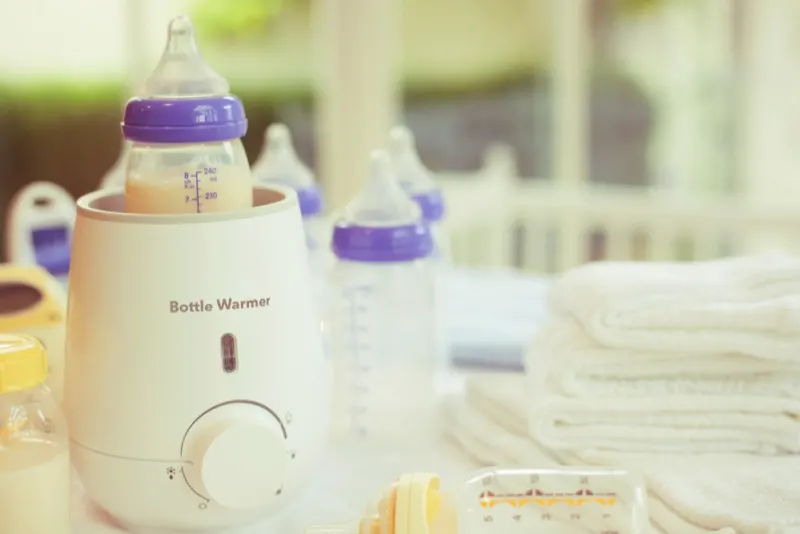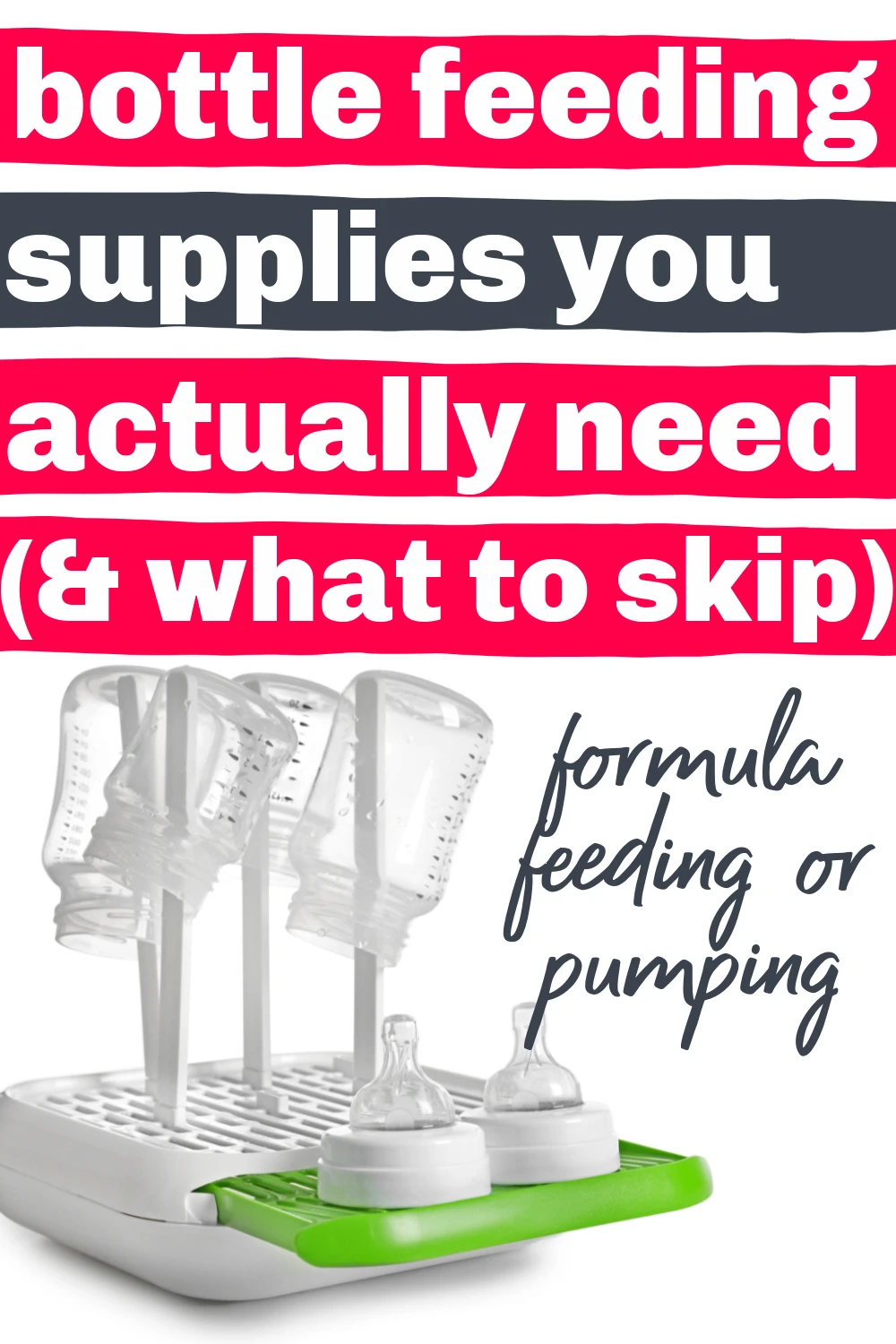Inside: Wondering what bottle feeding essentials you actually need when you’re first starting out, and what to skip? Get one bottle-feeding mom’s opinion on what’s essential, and what’s really not – with bottle-feeding supplies for both formula feeding parents and recommendations for pumping, bottle-feeding mamas, too.
As any formula feeding or exclusively pumping mom can tell you, bottle feeding can feel overwhelming at first. There are SO many things to consider, SO many choices to make.
- Which type of formula is best?
- Which bottle should I use?
- What gear will I need when I’m not at home?
- What is a must have and what can I do without?
Through my own past experiences pumping and formula feeding, I quickly learned which items were essential to making bottle feeding as easy as possible and which items I really regret wasting money on.
Some products I bought after other moms raved about them. Some were helpful…others just collected dust.
But with all of that buying and using and discarding, I did come across products I personally couldn’t live without. I have my own list of things I rave about to other moms.
So I’m going to share my own list of bottle feeding essentials, plus the items I tried that I would recommend skipping.
BUT. (This is a big “but”.)
You need to accept that bottle feeding is going to take a little (or a lot of) trial and error when it comes to the things you end up needing.
Especially if you’re purchasing these items before your baby arrives, you’re operating without a pretty key part of the equation: your baby.
Your baby might prefer a certain kind of bottle…that takes trying three different types of bottle to find.
They might need a different type of nipple. And you can probably guess how many you might have to go through to find the right one.
Then there’s the formula…well, you get the idea.
I wish this wasn’t the case. But ultimately, do the best you can with the information you have RIGHT NOW.
Spend your money on the essentials until you find ones that work. Then, if you want you can splurge on extras that *might* make your bottle-feeding life (see the “bottle feeding equipment you can probably skip” section) a little easier.
Related: The Benefits of Formula Feeding for Moms – What I Needed to Hear

Bottle Feeding Essentials for Formula Feeding and Pumping
THIS POST PROBABLY CONTAINS AFFILIATE LINKS. AS AN AMAZON ASSOCIATE, I EARN FROM QUALIFYING PURCHASES. YOU CAN READ OUR FULL DISCLOSURE POLICY HERE.
I’m sharing the essentials that apply to all bottle-feeding moms first, then one product specifically for formula feeding mamas.
Next, I’ll share what you’ll need if you are a breast milk pumping, bottle-feeding mama. That section starts with the breast pump and continues to the end of the list.
1. The Right Bottle
A pretty obvious staple when you’re bottle feeding, bottles should be easy, right?
But when you have so many bottle options to choose from, finding the right type can be tricky.
The key is finding a bottle that your baby is happy eating from, and one that is easy to clean. Trust me on that last part! THIS was my bottle of choice because it was super easy to clean, so if your baby will take it, go with this one – thank me later.
Some babies prefer a wider-based nipple, more like the shape of a breast. Others prefer to eat from nipples with a smaller base.
If your baby is happily sucking away, then you have probably found a winner.
There are bottles designed to help a baby with gas issues, but these bottles tend to have more pieces to clean. So if your baby doesn’t have gas issues, choose the simplest bottle possible.
If you know you are going to bottle feed, make sure to put PLENTY of bottles on your baby registry! The cost can add up.
Related: Baby Registry Tips for First-Time Parents (avoid novice mistakes)
2. The Right Nipple
Did you know that nipples come in a variety of flow rates? I sure didn’t.
But finding the right flow nipple for your baby is an essential part of successful bottle feeding. Nipples are usually labeled with either a number system or a description (Ex: 1, 2, 3, 4 — slow, medium, fast.)
Bottle manufacturers usually state the general recommended age for each type.
Start with the slowest flow for your newborn and as they grow and eat more ounces with each setting, you will be able to increase the flow as your baby grows.
Note: You can mix and match bottle and nipple brands, as long as the general shape is the same. I see no good reason for mixing unless your baby truly demands a certain nipple, but you want to keep the easy to clean bottle or you simply can’t find the matching nipple in the appropriate flow rate for your baby’s age.
Related: Is Your Baby Suddenly Refusing a Bottle? 7 Things to Try Before You Panic
3. Bottle Brush
You will be washing multiple bottles a day, especially in the first six months. A bottle brush is absolutely considered a bottle feeding essential.
Make sure you buy one that has an attachment that also cleans inside nipples.
THIS one was my go-to bottle brush for years, but it doesn’t have the attachment.
THIS one is a great alternative, plus it looks super cute next to your sink.
4. Bottle-Drying Rack
A drying rack (or tree) keeps your bottles and nipples organized and most importantly, upright, to allow for quicker drying.
I tried just using my regular dish drying rack for bottles, but they were constantly falling over and there really wasn’t a good place to put the nipples. I also didn’t like having it cluttering up my countertops.
A bottle drying rack was a cheap solution, and I used it daily.
The popular Boon grass drying racks look cute…until you need to clean gunk and nastiness and – God forbid – mold out from in between the “grass” blades.
Stick to a good old plastic one with a drain into the sink like THIS one.
Or if you prefer a more aesthetic and sustainable option, THIS bamboo one looks amazing, and it can probably be repurposed later on.
5. Microwavable Steam Clean Bag
When you need to sterilize nipples, these bags make it a breeze!
Pour in the recommended amount of water, add whatever you need sterilized, and steam clean for the recommended amount of time.
Microwaveable steam clean bags also work great for sterilizing pacifiers.
These are relatively cheap to buy, and I used mine all of the time.
6. Formula Dispenser
This is a small container that holds pre-measured formula, and is great for stashing in your diaper bag when you are traveling or away from your house for an extended period of time.
You will NOT want to stuff a regular-sized formula container in your diaper bag every time you have to leave the house.
Also, using a formula dispenser like THIS one when you are out and about is much cheaper than buying pre-mixed formula or single use packets.
If you’re part-time bottle feeding because of pumping, these next several items are for you. If you’re using formula, move on to the “what to skip” section.
7. Electric Breast Pump
If you are pumping regularly, you will want to have an electric pump versus a hand-held pump. It’s worth investing in a quality pump that will make pumping quicker and more efficient.
Check your medical insurance because many will cover the cost of an electric pump or will help cover the cost, although they may only cover a specific brand or type.
If you can, I recommend purchasing a double pump, because then you will be able to get twice the amount of milk in the same amount of time. And no mama wants to be pumping longer than she has to.
8. Hands-Free Pumping Bra
Whoever invented this contraption needs to win some kind of award.
A hands-free pumping bra is exactly what it sounds like. This bra allows you to do other things with your hands while pumping, or if nothing else, just saves your arms from having to hold bottles for an extended period of time.
If you plan to do a lot of pumping, I highly recommend one of these!
I honestly can’t give you a good recommendation here, but this lovely lactation consultant seems to know what’s up in this area, so be sure to check out THIS post with the best hands-free pumping bras.
9. Breast Milk Storage Supplies
If you have a good milk supply, hopefully you will be able to store some extra milk. Breast milk stays good in a freezer for around 9 months.
Use bags specifically designed for storing breast milk like THESE.
Mark the amount pumped, the time of day you pumped (this matters!!) and the date the breast milk was put in the freezer on the outside of the bag with a permanent marker.
Related: How to Store Frozen Breast Milk – A New Mom’s Guide
10. Bag for Storing/Transporting Pumping Supplies
If you plan on toting all this stuff back and forth to work, you are going to need a bag that can handle all.the.things.
THIS one is designed specifically to fit the Medela pump, but it could probably accommodate other brands. It also is made to fit a laptop and possibly other diaper bag essentials.
However, THIS one has a better cooler bag for storing breast milk at work or taking from the fridge at work TO home, and the price point is much more affordable with frequent sales.
Take your pick!
11. Disposable Nursing Pads
You might not be able to pump exactly when your body is ready, and chances are, you will encounter some leaking milk issues.
Disposable nursing pads like THIS kind are a must have to keep your bra and shirts dry, especially in public.
And if you’re thinking of getting the washable kind, do yourself a favor and skip them. They are nowhere close to as good as disposables if you are anything but the lightest leaker, unless of course you like feeling yucky and wet for hours?

Bottle Feeding Supplies You Can Probably Skip
When entering the baby section of any store, you will quickly realize you could spend a small fortune on baby gear. If you have the means and ample storage space, go wild!
But if you want to save money and space and only buy the necessities, then here are few items that you can probably live without.
Fancy Bottles
Unless your baby specifically deals with gas issues or has some other feeding issues, you don’t have to spend tons of money on fancy bottles.
The simpler the better! Why? Because you will spend hours washing bottle parts – you really don’t need more to wash.
Bottle Warmer
Before my first kiddo was born, I heard from other mamas that a bottle warmer was a must-have item. So of course, I bought one thinking I would use it all the time.
You can guess how this ends, right? It ended up just collecting dust on my counter.
The bottles I used the most didn’t end up fitting in the warmer. When mixing formula, I would just use room temperature or warmish water.
If I had any breast milk in bottles, I would set the bottle in a cup of a hot water for a little while – easy. Plus, you aren’t left with a difficult to get rid of, specialty baby item when you’re done with bottles.
Tip: If you can get your baby used to eating liquids that don’t always have to be the same temperature, it makes feeding on the go that much easier!
Name Brand Formula
One thing I was not prepared for when I started formula feeding was the cost of formula. I had NO idea it would be so expensive.
My first son had digestive issues, and our pediatrician recommend a name brand formula that addressed his specific issues, so that is what we used.
But with my second kiddo, I was able to use a generic formula. It was almost identical to the brand name equivalent, but significantly cheaper.
Most babies will do great on a store brand version of formula. We bought ours at Costco in bulk which also helped us save some money.
Filtered Water
Any type of clean water, tap or bottled, is fine to use to prepare formula.
If you are concerned about your home drinking water, talk with your water provider. You can have a simple test done to make sure it is safe.
If you want to use filtered water (personally I like the taste of filtered water better) go for it, but it’s usually not necessary to buy a filtering water system if you don’t already have one OR add to the cost of formula feeding by purchasing bottled water.
Dishwasher Caddy
A dishwasher caddy holds nipples so they don’t get lost inside your dishwasher. This was another item I bought thinking I would use all the time.
As much as I love using my dishwasher, I rarely used it to wash bottles because I usually needed the bottles before I actually got around to running the dishwasher.
It turned out NOT to be part of my bottle feeding essentials list.

Your Bottle Feeding Must-Haves Might Turn Out to Be Different Than Mine
Everyone’s bottle feeding experience is different.
Maybe you always planned to bottle-feed, or maybe you were thrust into it because of sickness or supply issues or allergies or tongue ties.
Maybe you have a ton to spend on bottle feeding supplies, or maybe you’re counting pennies to get the things you need.
What I feel are “must-haves” might not hold true for you, but I hope this at least gives you a place to start from a mom who actually bottle-fed both her babies.
As you navigate your bottle feeding journey, you might find items you thought you absolutely needed collecting dust. Other products will earn their place on your own “must-have” list.
The goal is to find the things that make your bottle feeding life easier, so you have lots of time to focus on what is most important: that sweet baby smiling up at you.
Read Next: Formula Feeding Tips for the New-to-Formula Mom
Mary Ann Blair is a stay-at-home mom living in the Pacific Northwest with her two little gentlemen and hubs. She loves connecting with other parents who like to keep it real!
Her writing has been published on Her View From Home, Perfection Pending, That’s Inappropriate, Pregnant Chicken, Sammiches and Psych Meds, Red Tricycle and in Chicken Soup For the Soul. She can be found at https://www.maryannblair.com